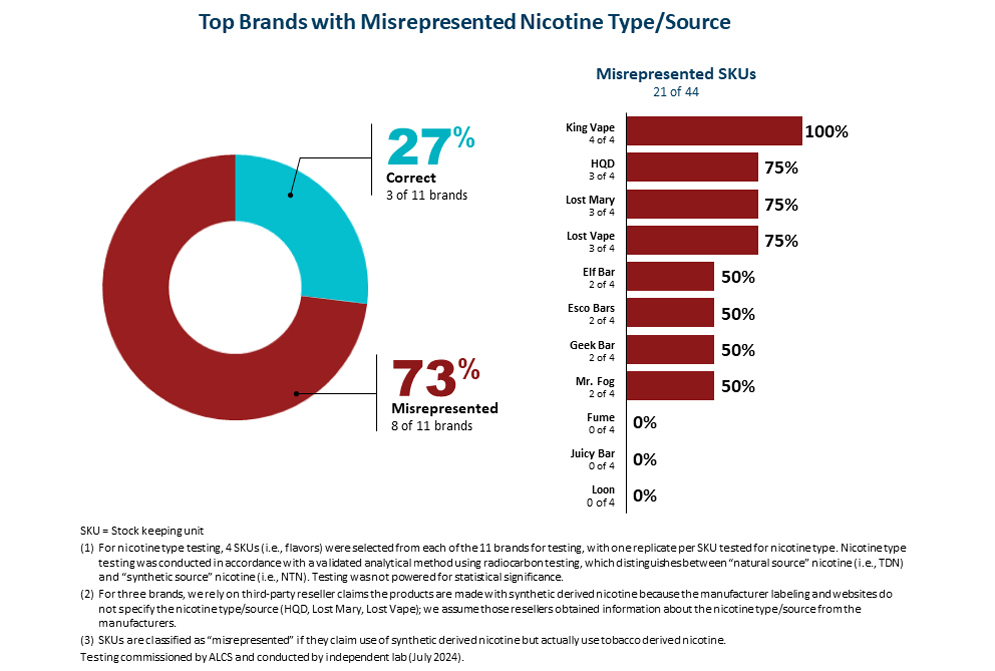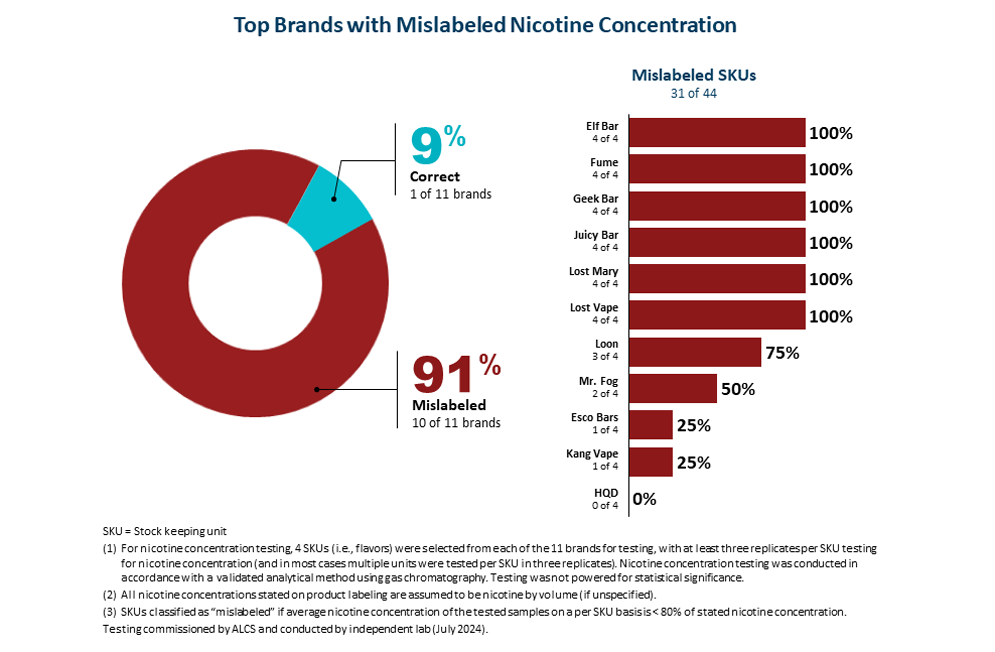Illicit E-Vapor Products Widely Mislabel their Nicotine Composition

Today, millions of adults who vape are using illicit e-vapor products lacking FDA oversight. The growth of illicit e-vapor products remains a significant problem that threatens the long-term success of federal tobacco regulation and undermines the public health protection it provides.
To better understand and evaluate the illicit market, Altria commissioned independent labs to analyze leading illicit e-vapor brands. This analysis found:
- 8 out of 11 illicit e-vapor brands misrepresented their nicotine source, using a different type of nicotine than they claimed. In fact, most of these products claim to use synthetic nicotine but actually contain tobacco-derived nicotine, likely to circumvent the FDA's 2020 PMTA submission deadline.
- 10 out of 11 illicit e-vapor brands misrepresented their nicotine concentration, with many of these brands being among the most frequently reported in the 2024 National Youth Tobacco Survey for 'any brand' use by current youth e-vapor users (middle and high school students).
- 2 out of 13 "zero nicotine" e-vapor products contain more than trace amounts of nicotine.
Collectively, these findings underscore a persistent failure in consumer protection and the risk to adults and youth when manufacturers intentionally circumvent regulations, operate without regulatory scrutiny, and face inadequate enforcement. In contrast, legal, regulated markets provide safeguards where underage prevention occurs, reduced-harm products are scientifically verified, and adult consumers can trust FDA oversight—protections entirely absent in illicit markets.
At Altria, we remain deeply committed to a well-regulated marketplace that delivers on harm reduction, as Congress intended with the Tobacco Control Act (TCA) of 2009. This requires that all tobacco products are manufactured, distributed, and sold within an FDA-regulated framework that minimizes underage use, offers adults who smoke proven lower-risk alternatives, and ensures all adult consumers benefit from FDA oversight of the products they purchase—something that current data indicates is not occurring.
-
8 out of 11 illicit e-vapor brands misrepresented their nicotine source
In 2020, manufacturers began inundating the e-vapor market with flavored disposable products, claiming to use synthetic nicotine to circumvent the FDA’s 2020 PMTA submission deadline. However, in 2022, Congress granted the FDA regulatory authority over synthetic nicotine products. As a result, any e-vapor products introduced to the market after the established deadlines—whether they contain synthetic or tobacco-derived nicotine—are considered illegal until they receive a Marketing Granted Order (MGO). This includes products that transitioned from synthetic to tobacco-derived nicotine. Additionally, illicit manufacturers, prioritizing profits over product integrity, may be motivated to use tobacco-derived nicotine instead of synthetic-derived nicotine due to the cost savings.
-
10 out of 11 illicit e-vapor brands misrepresented their nicotine concentration; with 6 of the 10 e-vapor brands mislabeling nicotine content across all tested SKUs
Illicit markets lack manufacturing and quality controls, resulting in significant consumer protection concerns, including potential product safety risks. Similarly, to the mislabeling of nicotine source, illicit manufacturers driven by profits may be incentivized to lower the amount of nicotine, thus decreasing their cost of goods. Most concerning is the impact lower-than-labeled nicotine concentration could have on the ability to support adults who smoke as they switch from combustible cigarettes.
-
2 out of 13 "zero nicotine" e-vapor products contain more than trace amounts of nicotine
With a lack of product stewardship and manufacturing controls, illicit manufacturers circumvent regulation and market e-vapor products labeled as ‘zero nicotine’ that do in fact contain more than trace amounts of nicotine1, specifically:
- Mr Fog Zero Nicotine SW15000 Banana Pancake was found to contain 1.8% nicotine by weight
- North FT12000 Zero Nicotine Blue Slurpie was found to contain 0.1% nicotine by weight
These findings underscore the need for enforcement against illicit e-vapor products to prevent adverse events among adults and youth.




